Manufacturing processes
Soda ash is one of the most widely used large-scale products of basic chemistry. Nowadays more than two thirds of its output belong to ammonia (Solvay) process, which uses sodium chloride salt, limestone or chalk as raw materials, whereas is used as an auxiliary substance. The varieties of ammonia process applied today are as follows:
1) Primary traditional Solvay method with minor peculiarities. Ammonia remains in process cycle, being recovered with lime milk.
2) Less widely used is the Akzo Nobel method. As distinct from traditional Solvay, here ammonia is recovered with dry lime. In 1958–2009 this process was operable in the Netherlands. Now its application is limited to China and two Indian plants. The engineering of a soda ash plant built in Brazil since 1971 is based on this method.
3) Combined ammonia (ammonium chloride) process with simultaneously obtained commercial ammonium chloride. This process is widely used in China (45% of all soda ash capacities in 2008), partially used by Central Glass in Japan. Small plants exist in India (Japanese project) and in Germany (BASF). A large plant operating this process is under construction in Indonesia since 1995 (Chinese project).



